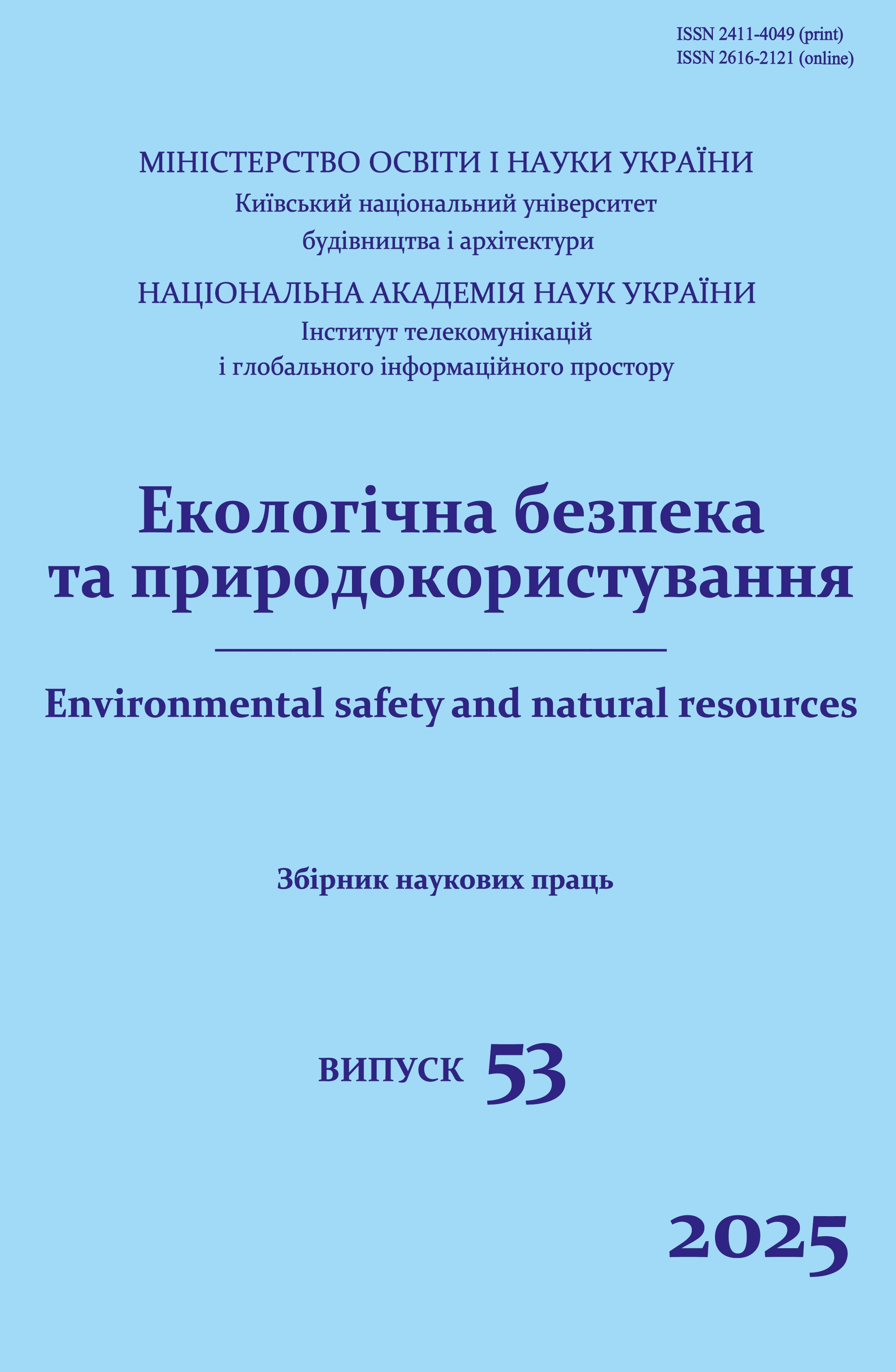Hydrological features and characteristics of water management activities in the lower reaches of the Sinyukha river
DOI:
https://doi.org/10.32347/2411-4049.2025.1.22-34Keywords:
river hydroecology, natural and climatic factors, hydrological regime of the river, flood hazard, impact of water management activitiesAbstract
The issue of conservation and protection of water resources has always been relevant in Ukraine. The situation is particularly catastrophic in the lower Pobuzhzhia, where the main source of water supply is the Southern Bug River and its tributaries. The most powerful tributary of the Southern Bug, which significantly affects the flow of the main river in the lower reaches, is the Syniukha River. However, like most rivers in the steppe zone, the Sinyukha River is constantly affected not only by anthropogenic activities but also by climate change. A characteristic feature of the river is its significant use in various fields: domestic and industrial water supply, irrigation, and recreation. The geological and landscape features of the basin ensure a significant year-round water content and a stable seasonal hydrochemical state. The river's water content is formed under the influence of a complex of physical and geographical factors and depends on climatic and hydrogeographical processes. In the context of climate instability in recent years, against the background of rising ambient temperatures and a powerful agrogenic transformation of the catchment, there has been a significant, more than twofold decrease in water flow, which has caused a number of negative reactions of the river hydrosystem and related natural objects. Currently, the water content is in a prolonged low-water phase, which began in 2007 and has been going on for 17 years. The current low-water phase observed in the lower reaches of the river is more stable and deeper than the previous ones, which may be related to climate change. Against the backdrop of powerful natural and climatic factors, anthropogenic impact on the river and its hydrological regime is of secondary importance, which is a rare phenomenon for steppe rivers. The current level of river runoff use does not violate the ecological status of the Syniukha River. To date, the Sinyukha River has retained its ecosystem functions, serving as a landscape and biotopic reserve for local biota. In addition, the river is an important source of drinking water supply for the population and a key means of replenishing and regulating groundwater conditions. The results of the study can be used in the development of flood control and water protection measures, as well as water management strategies in the lower Pobuzhzha.
References
World water assessment programme. UN World Water Development Report 2022. https://www.unwater.org/publications/un-world-water-development-report-2022/
National systems to support drinking-water, sanitation and hygiene: global status report 2019. UN-water global analysis and assessment of sanitation and drinking-water (GLAAS) 2019 report. Geneva: World Health Organization; 2019. Retrieved June, 24, 2020 from https://apps.who.int/iris/bitstream/handle/10665/326444/9789241516297-eng.pdf?ua=1
Glantz, M.H. (2018). Water security in the changing world. Bulletin WHO, 67 (1). Retrieved from https://public.wmo.int/ru/resources/bulletin
Afanasiev, S.O., Vasylchuk, T.O., Lietytska, O.M., & Bilous, O.P. (2012). Otsinka ekolohichnoho stanu richky Pivdennyi Buh u vidpovidnosti do vymoh Vodnoi Ramkovoi Dyrektyvy YeS. Kyiv: TOV «NVP Interservis» [in Ukrainian].
Khilchevskyi, V.K., Chunarov, O.V., & Romas, M.I. (2006). Vodohospodarska obstanovka v baseini r. Pivdennyi Buh ta vplyv na nei Pivdenno-Ukrainskoho enerhokompleksu. Melioratsiia i vodne hospodarstvo, 93-94, 63-69 [in Ukrainian].
Ukhan, O.O. (2016). Osoblyvosti prostorovo-chasovoho rozpodilu holovnykh ioniv, orhanichnykh rechovyn ta biohennykh elementiv za techiieiu r. Pivdennyi Buh. Liudyna ta dovkillia. Problemy neoekolohii, 1-2 (25), 20-30 [in Ukrainian].
Khilchevskyi, V.K., Chunarov, O.V. et al. (2009). Vodni resursy ta yakist richkovykh vod baseinu Pivdennoho Buhu. V.K. Khilchevskyi (Ed.). K.: Nika-Tsentr [in Ukrainian].
Ukhan, O.O., Osadchyi, V.I., Nabyvanets, Yu.B., Osadcha, N.M., & Hlotka, D.V. (2015). Typizatsiia poverkhnevykh vod baseinu Pivdennoho Buhu za vmistom holovnykh ioniv, biohennykh elementiv, orhanichnykh rechovyn ta rozchynenoho kysniu. Naukovi pratsi UkrNDHMI, 267, 46–56 [in Ukrainian].
Mahas, N.I., & Trokhymenko, A.H. (2013). Otsinka suchasnoho antropohennoho navantazhennia na basein richky Pivdennyi Buh. Ekolohichna bezpeka, 2 (16), 48–52 [in Ukrainian].
Mahas, N. I., Zhadan, N.M., & Tuz, R.V. (2024). Vyznachennia ekolohichno stiikykh ta pryiniatnykh rishen dlia zabezpechennia yakisnoho vodopostachannia m. Mykolaiv. Ekolohichni nauky: naukovo-praktychnyi zhurnal, 2 (53), 254-265 [in Ukrainian].
Vodnyi kodeks Ukrainy vid 06.06.1995 r. № 213/95-VR. Chynna redaktsiia vid 20.03.2023. Retrieved from https://ips.ligazakon.net/document/z950213?an=1 [in Ukrainian].
Baitsar, A.L. (2023). Heohrafiia ta kartohrafiia ukrainskykh istoryko-heohrafichnykh zemel (XII st. – poch. XX st.). Lviv-Vynnyky. Retrieved from https://geography.lnu.edu.ua/wp-content/uploads/2023/08/Baytsar_2023.pdf [in Ukrainian].
Vakhrushev, B.O. et al. (2010). Relief Ukrainy. V.V. Stetsiuk (ed.). Kyiv [in Ukrainian].
Ahroklimatychnyi dovidnyk po Mykolaivskii oblasti (1986-2005 rr.). (2011). L.M. Duranik i T.I. Adamenko (Eds.). Mykolaiv. obl. tsentr z hidrometeorolohii. Odesa: Astroprynt [in Ukrainian].
Mahas, N.I., & Tuz, R.V. (2024). Otsinka suchasnoho hidrolohichnoho stanu nyzhnoi dilianky richky Syniukha. Materialy IX zizdu Hidroekolohichnoho tovarystva Ukrainy. Dnipro [in Ukrainian].
Horbachova, L.O. (2013). Stroky ta tryvalist periodiv i sezoniv vodohospodarskoho roku v baseini richky Pivdennyi Buh. Nauk. pratsi UkrNDHMI, 265, 39-45 [in Ukrainian].
Vyshnevskyi, V.I. (2000). Richky i vodoimy Ukrainy. Stan i vykorystannia. Kyiv.
Hopchenko, Ye.D., Kichuk, N.S, & Ovcharuk, V.A. (2016). Maksymalnyi stik doshchovykh pavodkiv na richkakh Pivdnia Ukrainy. Odesa: ODEKU [in Ukrainian].
Vyshnevskyi, V.I., & Kutsyi, A.V. (2022). Bahatorichni zminy vodnoho rezhymu richok Ukrainy. Kyiv: Naukova dumka [in Ukrainian].
Rehionalna dopovid pro stan navkolyshnoho seredovyshcha u Mykolaivskii oblasti. Upravlinnia ekolohii ta pryrodnykh resursiv Mykolaivskoi oblderzhadministratsii. Retrieved from https://ecolog.mk.gov.ua/ua/ecoreports/regonalreport/ [in Ukrainian].
Downloads
Published
How to Cite
Issue
Section
License
Copyright (c) 2025 Nataliia Magas, Ruslan Tuz

This work is licensed under a Creative Commons Attribution 4.0 International License.
The journal «Environmental safety and natural resources» works under Creative Commons Attribution 4.0 International (CC BY 4.0).
The licensing policy is compatible with the overwhelming majority of open access and archiving policies.

